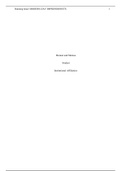Running head: MODERN-DAY IMPRESSIONISTS 1
Monnet and Matisse
Student
Institutional Affiliation:
,MODERN-DAY IMPRESSIONISTS 2
Introduction
Impressionism was an imaginative perspective wherein writers, painters, and authors
attempted to catch something fragmented, of apparent, a feeling. It depends on the conviction
that encounters in life are to a great extent impressions as opposed to nitty-gritty perceptions. To
accomplish this, impressionists focused on casualness and infrequently conveyed a moral
message (Hanson, 2017). They were additionally attached to nature and ordinary scenes like
sunsets, individuals in easygoing postures, water lilies in a lake, and so forth. This paper talks
about modern impressionists, mostly Monet and Matisse.
Monet the Father of Impressionism
Oscar-Claude Monet was born on November 14, 1840, France. When he was at the age of
five, Monet and his household relocated to Le Havre, where his forebear ran a grocery industry.
When he was 15 years old, Claude began his life as an artist by drawing caricatures (Monet, &
Rapelli, 1999). In 1858 he met Eugene Boudin, who introduced him to painting outside and
demonstrated how a scene could change as the light changes throughout the day. Monet’s focus
then changed from pencil drawings to paintings. In 1859, Monet travelled to Paris and began his
art studies. He studied at the Academia Suisse. In 1861, Monet entered the military. The
following year, he was discharged to poor health. He returned to Paris and continued studying
art. In 1874, Monet as well as other artists including Edgar Degas arranged for a public display
of their art (Mullarkey, 2015). These artists became known as impressionists.
Though Monet’s work had begun to attract attention, it wasn’t until the late 188-s that he
began to enjoy financial success. Camille had died in 1879, and in 1892, Monet got married. The
couple settled in France (History, 2014). Monet spent his late years travelling Europe, painting
, MODERN-DAY IMPRESSIONISTS 3
natural subjects such as the River James in London, England, and the canals of Vehicle, Italy
(Mullarkey, 2015). Claude Monet died on December 1926, in Giverny. Today, his home and
gardens are official historical monuments.
Monet was essential for a gathering of craftsmen called the Impressionists. Prior to them,
individuals preferred conventional canvases which were reasonable. Claude Monet consolidated
his adoration for nature and craftsmanship by making gardens any place he lived. Despite the
fact that he invested quite a bit of his energy in Paris and he voyaged widely in France and
abroad, Monet favored the rural area and lived for over fifty years along the Seine River. His
advantage in cultivating became throughout the long term, from flowerbeds that lit up his first
home throughout the long term, which turned into a joy for the eye, a relieving spot to consider
nature, and a wellspring of motivation (National Gallery of Art, 2013). Monet was particularly
enamored with drawing and painting his own personal gardens and often indicated the ways
light, climate, season, and season of fay outwardly transformed them, by legitimately watching
nature, Monet caught the passing impacts of light and air at canvas.
For Claude Monet the title impressionist consistently stayed a wellspring of pride: "I am,
and I generally wish to be, an impressionist". Regardless of the apparent multitude of things
pundits have expounded on his work, Monet kept on being a genuine impressionist to the furthest
limit of his extremely long life (Pierotti, 2018). He was filled by profound conviction and, for his
impressionism; he may have relinquished a large number of different open doors his colossal
ability waited for him. Monet didn't paint old style syntheses with figures, and he didn't turn into
a portraitist, despite the fact that his expert training incorporated those abilities. He picked a
solitary sort for himself, scene paint, and in that, he accomplished a level of flawlessness that
none of his peers figured out how to achieve (Brodskai︡︠a& Kalitina, 2015). Claude Monet was




